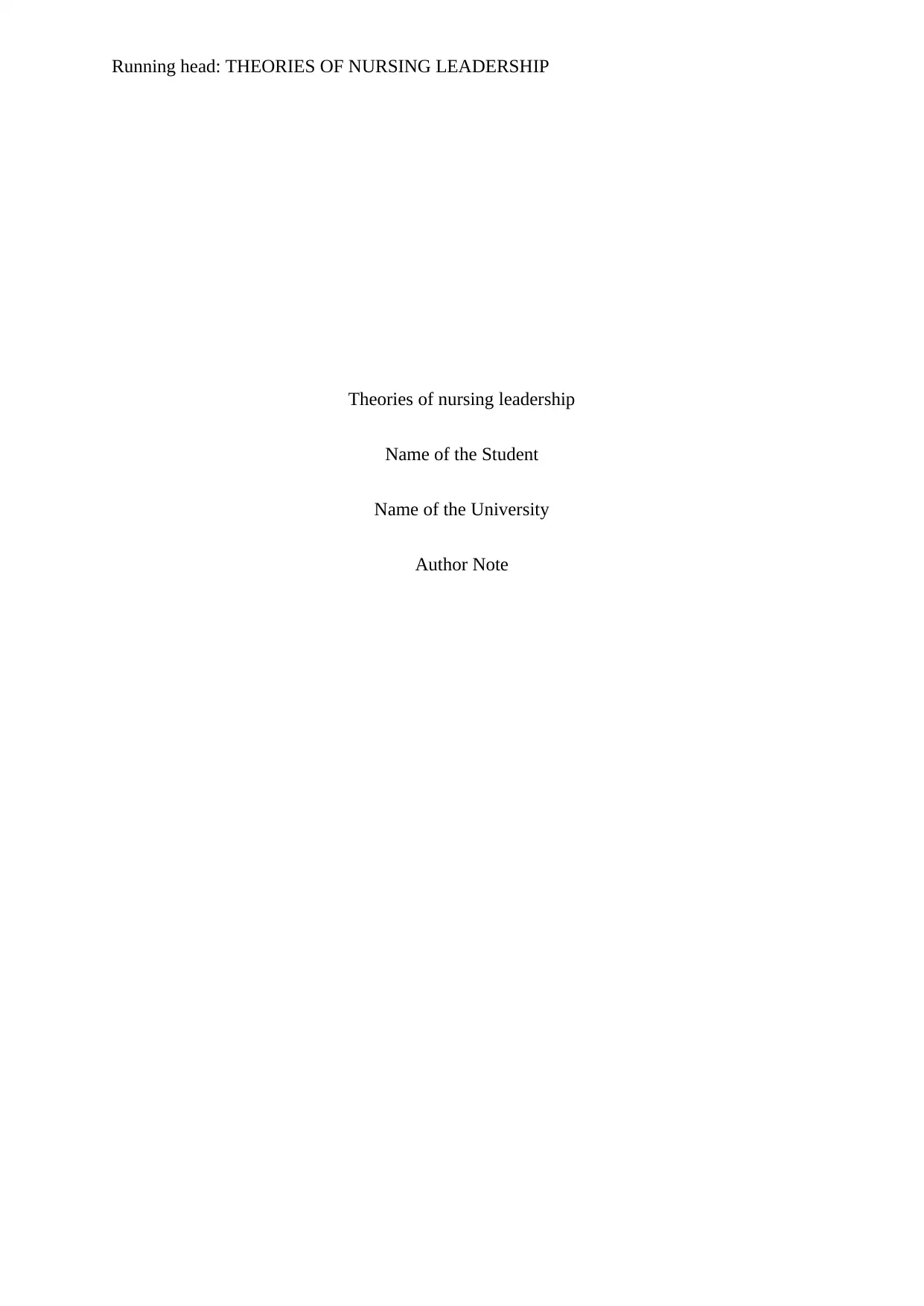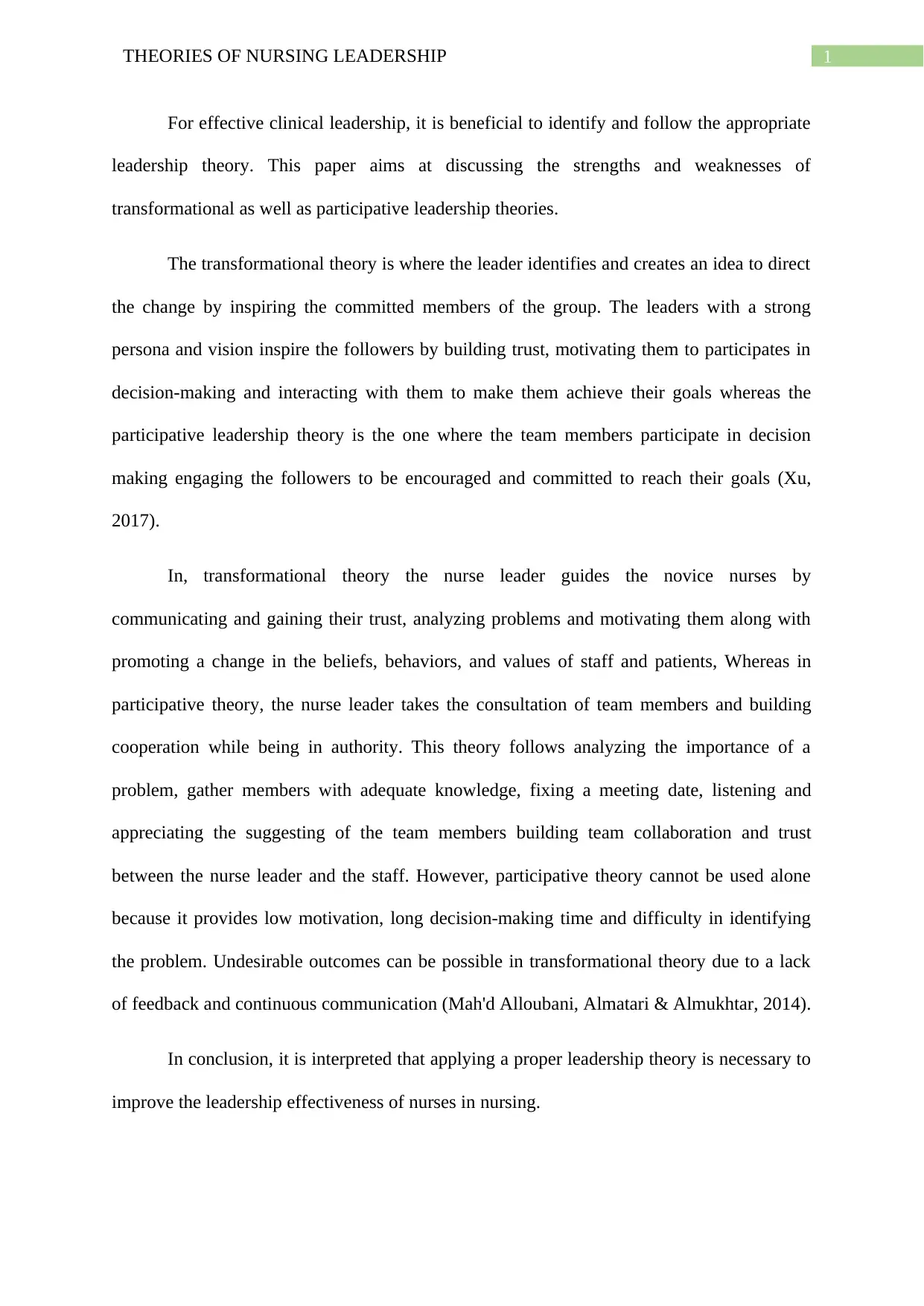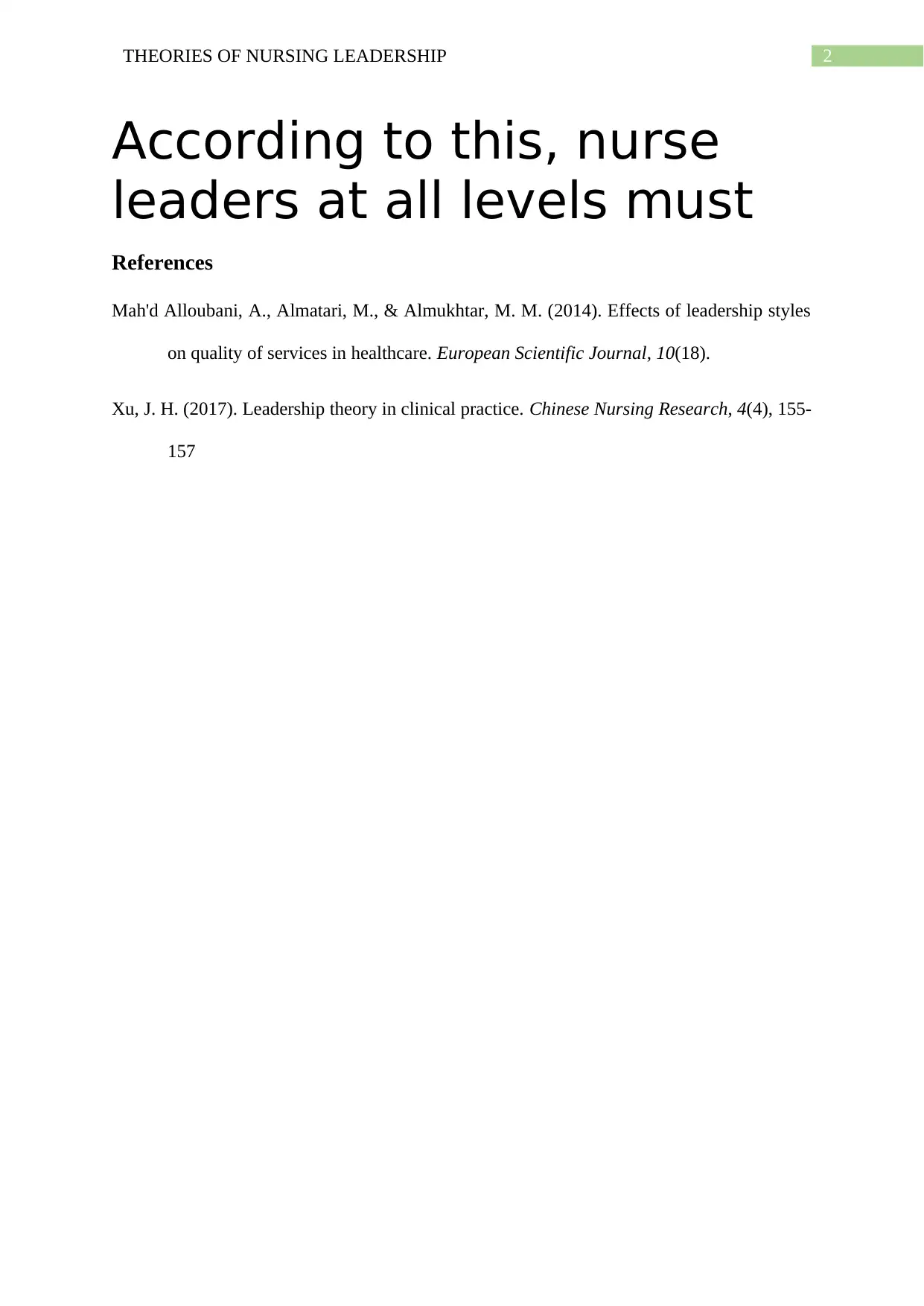Theories of Nursing Leadership: Strengths and Weaknesses
VerifiedAdded on 2022/08/13
|3
|414
|66
Report
AI Summary
This report analyzes two key leadership theories in nursing: transformational and participative leadership. Transformational leadership, as discussed, involves inspiring and motivating followers to achieve goals, fostering trust, and encouraging participation in decision-making. Conversely, partic...

Running head: THEORIES OF NURSING LEADERSHIP
Theories of nursing leadership
Name of the Student
Name of the University
Author Note
Theories of nursing leadership
Name of the Student
Name of the University
Author Note
Paraphrase This Document
Need a fresh take? Get an instant paraphrase of this document with our AI Paraphraser

1THEORIES OF NURSING LEADERSHIP
For effective clinical leadership, it is beneficial to identify and follow the appropriate
leadership theory. This paper aims at discussing the strengths and weaknesses of
transformational as well as participative leadership theories.
The transformational theory is where the leader identifies and creates an idea to direct
the change by inspiring the committed members of the group. The leaders with a strong
persona and vision inspire the followers by building trust, motivating them to participates in
decision-making and interacting with them to make them achieve their goals whereas the
participative leadership theory is the one where the team members participate in decision
making engaging the followers to be encouraged and committed to reach their goals (Xu,
2017).
In, transformational theory the nurse leader guides the novice nurses by
communicating and gaining their trust, analyzing problems and motivating them along with
promoting a change in the beliefs, behaviors, and values of staff and patients, Whereas in
participative theory, the nurse leader takes the consultation of team members and building
cooperation while being in authority. This theory follows analyzing the importance of a
problem, gather members with adequate knowledge, fixing a meeting date, listening and
appreciating the suggesting of the team members building team collaboration and trust
between the nurse leader and the staff. However, participative theory cannot be used alone
because it provides low motivation, long decision-making time and difficulty in identifying
the problem. Undesirable outcomes can be possible in transformational theory due to a lack
of feedback and continuous communication (Mah'd Alloubani, Almatari & Almukhtar, 2014).
In conclusion, it is interpreted that applying a proper leadership theory is necessary to
improve the leadership effectiveness of nurses in nursing.
For effective clinical leadership, it is beneficial to identify and follow the appropriate
leadership theory. This paper aims at discussing the strengths and weaknesses of
transformational as well as participative leadership theories.
The transformational theory is where the leader identifies and creates an idea to direct
the change by inspiring the committed members of the group. The leaders with a strong
persona and vision inspire the followers by building trust, motivating them to participates in
decision-making and interacting with them to make them achieve their goals whereas the
participative leadership theory is the one where the team members participate in decision
making engaging the followers to be encouraged and committed to reach their goals (Xu,
2017).
In, transformational theory the nurse leader guides the novice nurses by
communicating and gaining their trust, analyzing problems and motivating them along with
promoting a change in the beliefs, behaviors, and values of staff and patients, Whereas in
participative theory, the nurse leader takes the consultation of team members and building
cooperation while being in authority. This theory follows analyzing the importance of a
problem, gather members with adequate knowledge, fixing a meeting date, listening and
appreciating the suggesting of the team members building team collaboration and trust
between the nurse leader and the staff. However, participative theory cannot be used alone
because it provides low motivation, long decision-making time and difficulty in identifying
the problem. Undesirable outcomes can be possible in transformational theory due to a lack
of feedback and continuous communication (Mah'd Alloubani, Almatari & Almukhtar, 2014).
In conclusion, it is interpreted that applying a proper leadership theory is necessary to
improve the leadership effectiveness of nurses in nursing.

2THEORIES OF NURSING LEADERSHIP
According to this, nurse
leaders at all levels must
References
Mah'd Alloubani, A., Almatari, M., & Almukhtar, M. M. (2014). Effects of leadership styles
on quality of services in healthcare. European Scientific Journal, 10(18).
Xu, J. H. (2017). Leadership theory in clinical practice. Chinese Nursing Research, 4(4), 155-
157
According to this, nurse
leaders at all levels must
References
Mah'd Alloubani, A., Almatari, M., & Almukhtar, M. M. (2014). Effects of leadership styles
on quality of services in healthcare. European Scientific Journal, 10(18).
Xu, J. H. (2017). Leadership theory in clinical practice. Chinese Nursing Research, 4(4), 155-
157
⊘ This is a preview!⊘
Do you want full access?
Subscribe today to unlock all pages.

Trusted by 1+ million students worldwide
1 out of 3
Related Documents
Your All-in-One AI-Powered Toolkit for Academic Success.
+13062052269
info@desklib.com
Available 24*7 on WhatsApp / Email
![[object Object]](/_next/static/media/star-bottom.7253800d.svg)
Unlock your academic potential
© 2024 | Zucol Services PVT LTD | All rights reserved.





